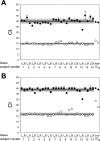Prevalence and abundance of latently transcribed varicella-zoster virus genes in human ganglia
- PMID: 17192313
- PMCID: PMC1866015
- DOI: 10.1128/JVI.02745-06
Prevalence and abundance of latently transcribed varicella-zoster virus genes in human ganglia
Abstract
In human ganglia latently infected with varicella-zoster virus (VZV), sequence analysis has revealed that five viral genes (VZV genes 21, 29, 62, 63, and 66) are transcribed. However, their comparative prevalence and abundance are unknown. Here, using real-time PCR, we analyzed 28 trigeminal ganglia from 14 humans for RNA corresponding to the five virus genes known to be transcribed in latently infected human ganglia. The most prevalent transcript found was VZV gene 63 (78%), followed by gene 66 (43%), gene 62 (36%), and gene 29 (21%). No gene 21 transcripts were detected in any of the 28 ganglia. VZV gene 63 RNA was also the most abundant (3,710 +/- 6,895 copies per 1 microg of mRNA) transcript detected in latently infected human ganglia, followed by VZV gene 29 (491 +/- 594), VZV gene 66 (117 +/- 85), and VZV gene 62 (64 +/- 38). Thus, the repeated detection and high abundance of VZV gene 63 transcripts in latently infected ganglia suggests that VZV gene 63 may be more important for the maintenance of virus latency than the less abundantly transcribed and randomly detected VZV genes 21, 29, 62, and 66.
Figures







References
-
- Cohrs, R., R. Mahalingam, A. N. Dueland, W. Wolf, M. Wellish, and D. H. Gilden. 1992. Restricted transcription of varicella-zoster virus in latently infected human trigeminal and thoracic ganglia. J. Infect. Dis. 166(Suppl. 1):S24-S29. - PubMed
Publication types
MeSH terms
Substances
Grants and funding
LinkOut - more resources
Full Text Sources
Other Literature Sources

